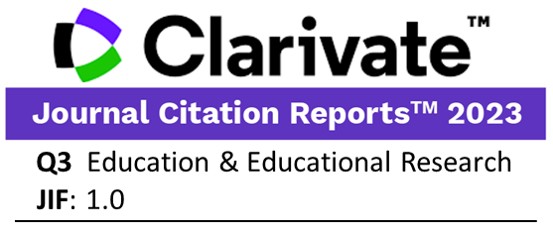Emotions and Sense of Self-Efficacy of Pre-Service English Teachers
DOI:
https://doi.org/10.24320/redie.2020.22.e25.2686Keywords:
Emotions, language teaching, self-efficacy, teaching practiceAbstract
The aim of this study was to explore changes in the emotional states and sense of self-efficacy of trainee English teachers in their teaching internship, establish the relationship between these two constructs, and determine the trigger of these emotional states. A qualitative exploratory design was employed to conduct the study, which involved ten pre-service English teachers. The findings indicate that all student teachers experienced negative emotional states at the beginning of their internship, which were triggered by the fact they were giving classes. Their sense of self-efficacy was initially low, but gradually increased over the course of their intership. Their emotions also shifted from negative to positive over the same period. Negative emotions appear to produce a low sense of self-efficacy in the way positive ones lead to a high sense of self-efficacy.Downloads
References
Andrade, N. F. (2016). La gustatividad en la formación docente: un fenómeno afectivo emergente. Revista Electrónica de Investigación Educativa, 18(2), 92-04. http://redie.uabc.mx/redie/article/view/817
Anttila, H., Pyhältö, K., Soini, T. y Pietarinen, J. (2016). How does it feel to become a teacher? Emotions in teacher education. Social Psychology of Education, 48(10), 59-63. https://doi.org/10.1007/s11218-016-9335-0
Arizmendi, S., Gillings, B. S. y López, C. L. de J. (2016). How novice EFL teachers regulate their negative emotions. How, 23(1), 30-48. https://doi.org/10.19183/how.23.1.299
Asociación Nacional de Universidades e Instituciones de Enseñanza Superior. (2016). Anuario Estadístico de la Educación Superior 2016-2017. http://www.anuies.mx/informacion-y-servicios/informacion-estadistica-de-educacion-superior/anuario-estadistico-de-educacion-superior
Babaei, M. y Abednia, A. (2016).Reflective teaching and self-efficacy beliefs: Exploring relationships in the context of teaching EFL in Iran. Australian Journal of Teacher Education, 41(9), 1-26. http://ro.ecu.edu.au/ajte/vol41/iss9/1
Bandura, A. (1997). Self-efficacy: the exercise of control. Worth Publishers.
Berg, D. A. G. y Smith, L. F. (2014). Pre-service teachers’ efficacy beliefs and concerns in Malaysia, England and New Zealand. Issues in Educational Research, 24(1), 21-40. http://www.iier.org.au/iier24/berg.pdf
Bernard, H. R., Wutich, A. Y. y Ryan, J. W. (2017). Analyzing qualitative data: systematic approaches. Sage.
Cabaroglu, N. (2014). Professional development through action research: Impact on self-efficacy. System, 44, 79-88. https://doi.org/10.1016/j.system.2014.03.003
Chacón, E. J. y Chacón, C. T. (2010). Un modelo para medir el sentido de autoeficacia docente en profesores de inglés como lengua extranjera en secundaria. Revista Evaluar, 10, 1-21. https://revistas.unc.edu.ar/index.php/revaluar/article/view/456
Choi, E. y Lee, J. (2018). EFL teachers’ self-efficacy and teaching practices. ELT Journal, 72(2), 175-186. https://doi.org/10.1093/elt/ccx046
Cocca, M. y Cocca, A. (2016). Self-efficacy in pre-school and primary teachers: does experience, educational background, and teaching level matter? International Conference on Education and New Learning Technologies, Barcelona. https://library.iated.org/view/COCCA2016SEL
Covarrubias, C. G. y Mendoza, M. (2015). Sentimiento de autoeficacia en una muestra de profesores chilenos desde las perspectivas de género y experiencia. Estudios Pedagógicos, 41(1), 63-78. https://doi.org/10.4067/S0718-07052015000100004
Creswell, J. W. y Creswell, J. D. (2018). Research design: qualitative, quantitative, and mixed methods approaches. Sage.
Dávila, M, A., Borrachero, A. B., Cañada, F., Martínez, G. y Sánchez, J. (2015). Evolución de las emociones que experimentan los estudiantes del grado de maestro en educación primaria, en didáctica de la materia y la energía. Revista Eureka sobre Enseñanza y Divulgación de las Ciencias, 12(3), 550-564. https://revistas.uca.es/index.php/eureka/article/view/2942
Fajardo, J. A. y Miranda. I. R. (2015). The paradox of the practicum: affinity to and resistance towards teaching. Íkala, Revista de Lenguaje y Cultura, 20(3), 329-341. https://doi.org/10.17533/udea.ikala.v20n3a04
Filatov, K. y Phil, S. (2015). The relationship between university learning experiences and English teaching self-efficacy: perspectives of five final-year pre-service English teachers. Australian Journal of Teacher Education, 40 (6), 33-59. http://dx.doi.org/10.14221/ajte.2015v40n6.3
Fletcher, T. y Kosnik, C. (2016). Pre-service primary teachers negotiating physical education identities during the practicum. Education, 3(13), 556-565. https://doi.org/10.1080/03004279.2016.1169486
Fuller, F. F. y Brown, O. H. (1975). Becoming a teacher. En K. Ryan (Ed.), Teacher education: 74th yearbook of the National Society of Education (pp. 25-52). University of Chicago Press.
Hascher. T. y Hagenauer, G. (2016). Openness to theory and its importance for pre-service teachers’ self-efficacy, emotions, and classroom behavior in the teaching practicum. International Journal of Educational Research, 77, 15-25. https://doi.org/10.1016/j.ijer.2016.02.003
Hernández, V. (2017). Las competencias emocionales del docente y su desempeño profesional. Alternativas en Psicología, 37, 79-92. http://www.alternativas.me/attachments/article/147/06%20%20Las%20competencias%20emocionales%20del%20docente.pdf
Isenbarger, L. y Zembylas, M. (2006). The emotional labor of caring in teaching. Teaching and Teacher Education, 22(1), 120-134. https://doi.org/10.1016/j.tate.2005.07.002
Kim, H. y Cho, Y. (2014). Pre-service teachers’ motivation, teacher efficacy, and expectation of reality shock. Asia-Pacific Journal of Teacher Education, 42(1), 67-81. https://doi.org/10.1080/1359866X.2013.855999
Külekçi, G. (2011). A study on pre-service English teachers’ self-efficacy beliefs depending on some variable. International Online Journal of Educational Sciences, 3(1), 245-260. http://www.acarindex.com/dosyalar/makale/acarindex-1423904420.pdf
Lavy, S. y Eshet, R. (2018). Spiral effects of teachers’ emotions and emotion regulation strategies: evidence from a daily diary study. Teaching and Teacher Education, 73, 151-161. https://doi.org/10.1016/j.tate.2018.04.001
Liaw, E. (2009). Teacher efficacy of pre-service teachers in Taiwan: the influence of classroom teaching and group discussions. Teaching y Teacher Education, 25(1), 176-180. https://doi.org/10.1016/j.tate.2008.08.005
MA, K. y Cavanagh, M. S. (2018). Classroom ready? Pre-service teachers’ self-efficacy for their first professional experience placement. Australian Journal of Teacher Education, 43(7), 134-151. http://dx.doi.org/10.14221/ajte.2018v43n7.8
Martins, M., Costa, J. y Onofre, M. (2015). Practicum experiences as sources of pre-service teachers’ self-efficacy. European Journal of Teacher Education, 38(2), 263-279. https://doi.org/10.1080/02619768.2014.968705
McNeill, C. (junio 2018). Exploratory research: 3 reasons to conduct more of it [mensaje de blog]. https://www.gutcheckit.com/blog/3-reasons-conduct-exploratory-research/
Moafian, F. y Ghanizadeh, A. (2009). The relationship between Iranian EFL teachers’ emotional intelligence and their self-efficacy in language institutes. System, 37, 708-718. https://doi.org/10.1016/j.system.2009.09.014
Moradkhani, S. y Haghi, S. (2017). Context-based sources of EFL teachers' self-efficacy: Iranian public schools versus private institutes. Teaching and Teacher Education, 67, 259-269. https://doi.org/10.1016/j.tate.2017.06.019
Morales, Y. A. (2016). Unveiling pre-service teachers’ attitudes toward teaching: The role of pedagogical practicums. PROFILE Issues in Teachers’ Professional Development, 18(2), 47-61. http://dx.doi.org/10.15446/profile.v18n2.49591
Mugford, G.; Sughrua, W. y López-Gopard, M. (2015).Construction of an English language teacher identity: perceptions and contrasts in Mexico. Mextesol Journal, 39(2), 1-11. http://mextesol.net/journal/public/files/b10c8a78ad61810720dae2274a1aa0e0.pdf
Notimex. (11 de julio de 2017). Enseñanza del inglés es una política de igualdad: Aurelio Nuño. Excelsior. https://www.excelsior.com.mx/nacional/2017/07/11/1174984
O’Donogue, J. L. (2015). Sorry, el aprendizaje del inglés en México. Mexicanos Primero.
Ramírez, J. L. (Coord.) (2013). Una década de búsqueda: las investigaciones sobre la enseñanza y el aprendizaje de lenguas extranjeras en México (2000-2011). Pearson, Universidad de Sonora, UNAM, Universidad de Colima.
Ramírez, J. L., Sayer, P. y Pamplon, E. N. (2014). English language teaching in public primary schools in Mexico: the practices and challenges of implementing a national language education program. International Journal of Qualitative Studies in Education, 27(8), 1020-1043. https://doi.org/10.1080/09518398.2014.924638
Rastegar, M. y Memarpour, S. (2009). The relationship between emotional intelligence and self-efficacy among Iranian EFL teachers. System, 37(4), 700-707. https://doi.org/10.1016/j.system.2009.09.013
Reyes, M. R. y Murrieta, G. (2017). Los futuros profesores de inglés: experiencia previa y sentido de autoeficacia. Mextesol Journal, 41(2), 1-17. http://www.mextesol.net/journal/index.php?page=journal&id_article=2085
Robertson, D. L. (2018). Emotion and professors’ developmental perspectives on their teaching. New Directions for Teaching and Learning, 153, 13-23. https://doi.org/10.1002/tl.20277
Ryan, K. (1986). The induction of new teachers. Phi Delta Kappa Educational Foundation.
Saldaña, J. (2016). The coding manual for qualitative researchers. Sage.
Schutz, P. A., Hong, J. Y., Cross, D. I. y Osbon, J. N. (2006). Reflections on investigating emotions in educational activity settings. Educational Psychology Review, 18(4), 343-360.
Seidman, I. (2013). Interviewing as qualitative research. A guide for researchers in Education and the Social Sciences. Teachers College Press.
Suárez, S. A. y Basto, E. A. (2017). Identifying pre-service teachers’ beliefs about teaching EFL and their potential changes. PROFILE Issues in Teachers’ Professional Development, 19(2), 167-184. http://dx.doi.org/10.15446/profile.v19n2.59675
Tagle, T., Del Valle, R., Flores, L. y Ackley, B. (2012). Las creencias de autoeficacia percibida de estudiantes de pregrado de pedagogía en inglés. Revista Iberoamericana de Educación, 58(4), 1-2. https://rieoei.org/historico/deloslectores/4667Tagle.pdf
Tschannen-Moran, M., Hoy, A. W. & Hoy, W. K. (1998). Teacher efficacy: its meaning and measure. Review of Educational Research, 68(2), 202-248.
Voss, T., Wagner, W., Klusmann, U., Trautwein U. y Kunter, M. (2017). Changes in beginning teachers’ classroom management knowledge and emotional exhaustion during the induction phase. Contemporary Educational Psychology, 51, 170-184. https://doi.org/10.1016/j.cedpsych.2017.08.002
Wheatley, K. F. (2002). The potential benefit of teacher self-efficacy doubts for educational reform. Teaching and Teacher Education, 18(1), 5-22. https://doi.org/10.1016/S0742-051X(01)00047-6
Yin, H., Huang, S. y Lee, J. (2017).Choose your strategy wisely: examining the relationships between emotional labor in teaching and teacher efficacy in Hong Kong primary schools. Teaching and Teacher Education, 66, 127-136. https://doi.org/10.1016/j.tate.2017.04.006
Zembylas, M. (2005). Teaching with emotions: a postmodern enactment. Information Age.
Downloads
-
HTML
-
PDF
-
XMLSPANISH 71
Article abstract page views: 2554
Published
2020-10-22License
Copyright (c) 2020 Revista Electrónica de Investigación Educativa

This work is licensed under a Creative Commons Attribution-NonCommercial 4.0 International License.














